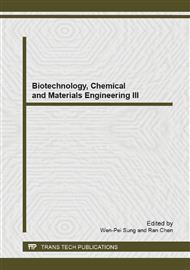[1]
Singer, P.C. Control of disinfection by-products in drinking water. J. Environ. Eng. 120 (1994), pp.727-744.
DOI: 10.1061/(asce)0733-9372(1994)120:4(727)
Google Scholar
[2]
Muellner, M.G., Wagner, E.D., Mccalla, K., et al. Haloacetonitriles vs. regulated haloacetic acids: are nitrogen-containing DBFs more toxic? . Environ. Sci. Technol. 41 (2007), pp.645-651.
DOI: 10.1021/es0617441
Google Scholar
[3]
H. Komulainen. Experimental cancer studies of chlorinated by products. Toxicology. 198 (2004), pp.239-248.
DOI: 10.1016/j.tox.2004.01.031
Google Scholar
[4]
Wei Liu, Lok-Man Cheung, Xin Yang, et al. THM, HAA and CNCl formation from UV irradiation and chlor(am)ination of selected organic waters. Wat. Res. 40 (2006), p.2033-(2043).
DOI: 10.1016/j.watres.2006.03.019
Google Scholar
[5]
G.H.R. Silva, L.A. Daniel, H. Buring, et al. Anaerobic effluent disinfection using ozone: Byproducts formation. Bioresource Technol. 101 (2010), pp.6981-6986.
DOI: 10.1016/j.biortech.2010.04.022
Google Scholar
[6]
V. Camel and A. Bermond. The use of ozone and associated oxidation processes in drinking water treatment. Wat. Res. 32 (1998), pp.3208-3222.
DOI: 10.1016/s0043-1354(98)00130-4
Google Scholar
[7]
S.K. Dentel and J.M. Gossett. Mechanisms of coagulation with Aluminum salts. J. AWWA. 88 (1988), pp.187-198.
Google Scholar
[8]
Weishaar J. L., Aiken G. R., Bergamaschi B.A., et al. Evaluation of specific ultraviolet absorbance as an indicator of the chemical composition and reactivity of dissolved organic carbon. Environ. Sci. &Technol. 37 (2003), pp.4702-4708.
DOI: 10.1021/es030360x
Google Scholar
[9]
J.K. Edzwald, W.C. Becker and K.L. Wattier. Surrogate parameters for monitoring organic matter and THM precursors. J. AWWA. 77 (1985), pp.122-132.
DOI: 10.1002/j.1551-8833.1985.tb05521.x
Google Scholar
[10]
Arzu Teksoy, Ufuk Alkan, Huseyin Savas., et al. Influence of the treatment process combinations on the formation of THM species in water. Separation and Purification Technol. 61 (2008), pp.447-454.
DOI: 10.1016/j.seppur.2007.12.008
Google Scholar
[11]
R. Sadiq and M.J. Rodriguez. Disinfection by-products (DBPs) in drinking water and the predictive models for their occurrence: a review. Sci. Tot. Environ. 321 (2004), pp.21-46.
DOI: 10.1016/j.scitotenv.2003.05.001
Google Scholar
[12]
Yali Song, Bingzhi Dong, Naiyun Gao, et al. Huangpu River water treatment by microfiltration with ozone pretreatment. Desalination. 250 (2010), pp.71-75.
DOI: 10.1016/j.desal.2009.06.047
Google Scholar
[13]
Roccaro P and Vagliasindi F.G.A. differential vs. absolute UV absorbance approaches in studying NOM reactivity in DBPs formation: Comparison and applicability. Wat. Res. 43 (2009), pp.744-750.
DOI: 10.1016/j.watres.2008.11.007
Google Scholar
[14]
Singer, P.C. Humic substances as precursors for potentially harmful disinfection byproducts. Wat. Sci. Technol. 40 (1999), pp.25-30.
DOI: 10.2166/wst.1999.0434
Google Scholar
[15]
G. Kleiser and F.H. Frimmel. Removal of precursors for disinfection by-products DBPs- differences between ozone- and OH-radical-induced oxidation. Sci. Tot. Environ. 256 (2000), pp.1-9.
DOI: 10.1016/s0048-9697(00)00377-6
Google Scholar
[16]
Rupa Lamsal, Margaret E. Walsh, Graham A. Gagnon. Comparison of advanced oxidation processes for the removal of natural organic matter. Wat. Res. 45 (2011), pp.3263-3269.
DOI: 10.1016/j.watres.2011.03.038
Google Scholar
[17]
Cao nan, Miao Tingting, Li Kuixiao, et al. Formation potentials of typical disinfection byproducts and changes of genotoxicity for chlorinated tertiary effluent pretreated by ozone. J. Environ. Sci. 21 (2009), pp.409-413.
DOI: 10.1016/s1001-0742(08)62284-6
Google Scholar


